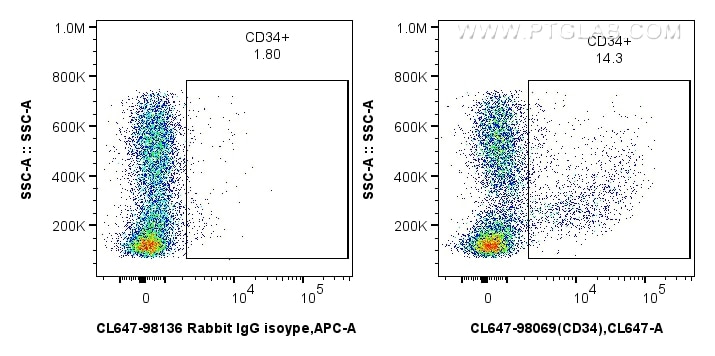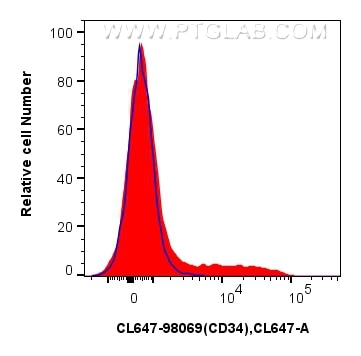Validation Data Gallery
Tested Applications
| Positive FC detected in | mouse bone marrow cells |
Recommended dilution
| Application | Dilution |
|---|---|
| Flow Cytometry (FC) | FC : 0.25 ug per 10^6 cells in 100 μl suspension |
| This reagent has been tested for flow cytometric analysis. It is recommended that this reagent should be titrated in each testing system to obtain optimal results. | |
| Sample-dependent, Check data in validation data gallery. | |
Product Information
CL647-98069 targets CD34 in FC applications and shows reactivity with mouse samples.
| Tested Reactivity | mouse |
| Host / Isotype | Rabbit / IgG |
| Class | Recombinant |
| Type | Antibody |
| Immunogen |
CatNo: Eg0854 Product name: Recombinant mouse CD34 protein Source: mammalian cells-derived, pHZ-KIsec-C-6*HIS Tag: C-6*HIS Domain: 35-287 aa of NM_133654 Sequence: TTETSTQGISPSVPTNESVEENITSSIPGSTSHYLIYQDSSKTTPAISETMVNFTVTSGIPSGSGTPHTFSQPQTSPTGILPTTSDSISTSEMTWKSSLPSINVSDYSPNNSSFEMTSPTEPYAYTSSSAPSAIKGEIKCSGIREVRLAQGICLELSEASSCEEFKKEKGEDLIQILCEKEEAEADAGASVCSLLLAQSEVRPECLLMVLANSTELPSKLQLMEKHQSDLRKLGIQSFNKQDIGSHQSYSRKT 相同性解析による交差性が予測される生物種 |
| Full Name | CD34 antigen |
| Calculated molecular weight | 41 kDa |
| GenBank accession number | NM_133654 |
| Gene Symbol | CD34 |
| Gene ID (NCBI) | 12490 |
| Conjugate | CoraLite® Plus 647 Fluorescent Dye |
| Excitation/Emission maxima wavelengths | 654 nm / 674 nm |
| Form | |
| Form | Liquid |
| Purification Method | Protein A purification |
| UNIPROT ID | Q64314 |
| Storage Buffer | PBS with 0.09% sodium azide{{ptg:BufferTemp}}7.3 |
| Storage Conditions | Store at 2-8°C. Avoid exposure to light. Stable for one year after shipment. |
Background Information
CD34 is a 105- to 120-kDa glycophosphoprotein expressed on the majority of hematopoietic stem/progenitor cells, bone marrow stromal cells, capillary endothelial cells, embryonic fibroblasts, and some nerve tissue. CD34 is a commonly used marker for identifying human hematopoietic stem/progenitor cells and mediates cell adhesion and lymphocyte homing by binding L-selectin and E-selectin ligands. CD34 is also one of the best negative selection markers for characterizing and/or isolating human MSCs from bone marrow and other sources. Along with other positive selection markers (such as CD29, CD44, CD90, CD105 and CD166), negative selection markers (such as CD34 and CD45) are used for MSC identification.
Protocols
| Product Specific Protocols | |
|---|---|
| FC protocol for CL Plus 647 CD34 antibody CL647-98069 | Download protocol |
| Standard Protocols | |
|---|---|
| Click here to view our Standard Protocols |


